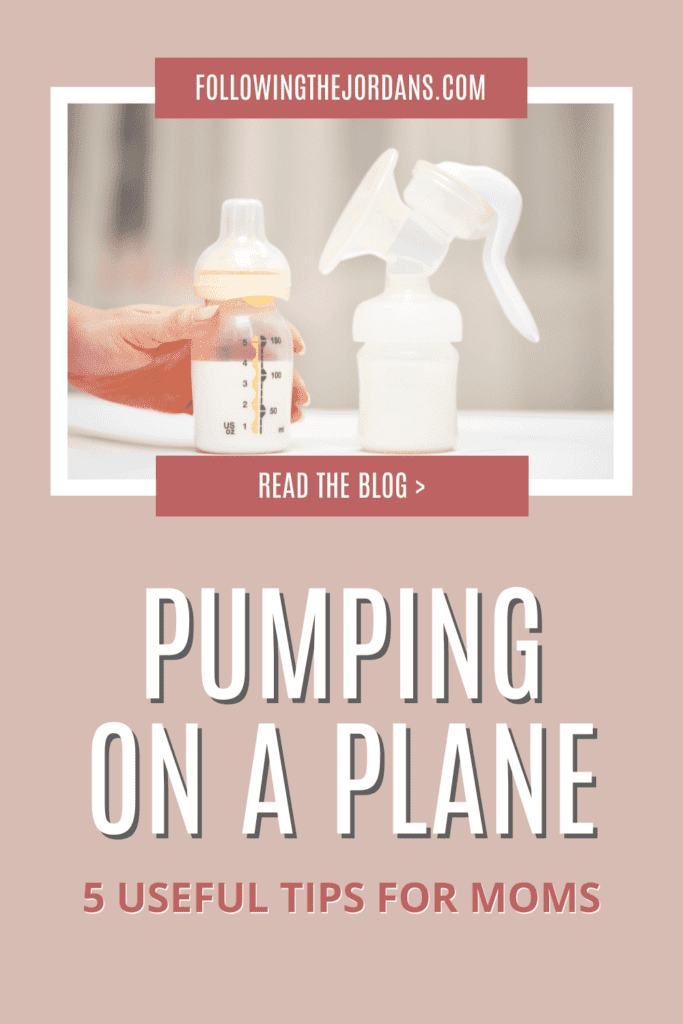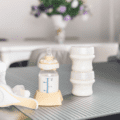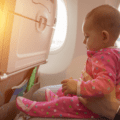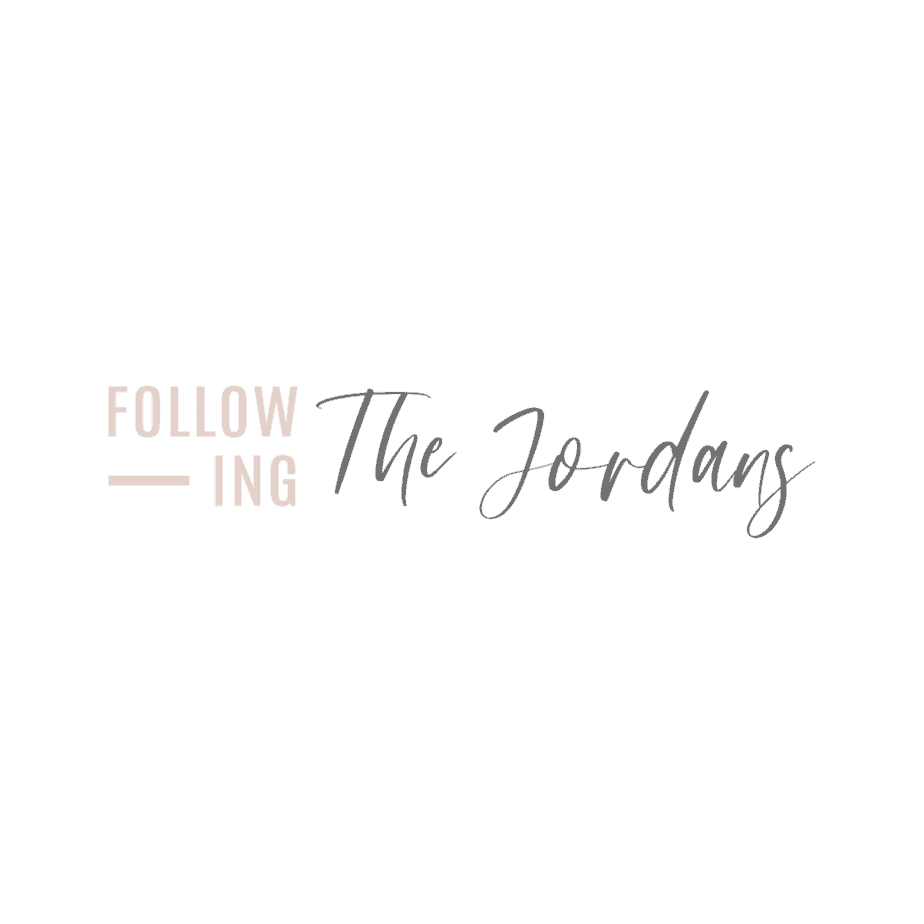Pumping on a Plane: 5 Useful Tips for Moms
Traveling while breastfeeding may be a bit more complicated, but it becomes more difficult when you’re traveling by airplane. You might feel embarrassed to breastfeed or try pumping on a plane, but sometimes on a travel day, you may have to pump at an airport or on an airplane.
Don’t be embarrassed or nervous! Pumping on a plane is easier than you imagine, and no matter what you may think, nearly all airlines permit mothers to pump while on the airplane.
It may be a bit uncomfortable; let’s be honest – those airline seats aren’t comfy!
I’ve traveled by airplane often and breastfed my babies so I know all about breastfeeding and pumping on a plane. Here is what you need to know!
Pin this blog for later! ↓

Related: 8 Tips for Breastfeeding on a Plane and Important Policies to Know
TSA Breast Pump Policy
Before flying with your breast pump, it’s a wise idea to read the TSA breast pump policy. The policy states flyers may keep breast pumps in checked bags and carry-on bags.
Most mothers recommend carrying your breast pump on the plane with you, even if you don’t plan to pump in the air, because luggage is often tossed around. You don’t want to reach your destination only to discover your pump broke.
Before leaving for the airport, look up the policy for the airline you plan to fly. Many consider breast pumps a medical device, so it won’t count as a carry-on bag.
For example, Delta clearly states in their policy that breast pumps are permitted on board. United Airlines states that mothers may bring a breast pump on board, along with a cooler in their carry-on bag.
Chances are you won’t encounter a problem, but I suggest coming with the policy printed and highlighted to show workers.
How to Fly with Breast Milk

Breast milk is not the same as carrying a soda or water onto an airplane. Instead, breast milk is considered a medical liquid by TSA, so it’s not subject to liquid restrictions like other liquids. Parents may carry a “reasonable amount” of breast with them on an airplane.
The TSA does not indicate what a reasonable amount is, so you are free to make that decision.
As you go through TSA, be aware that you need to take out the cooler and allow the screener to scan the breast milk. In some cases, TSA may test the milk as well; they look for liquids for explosives. If you want your breast milk to avoid being opened or x-rayed, be sure to ask the TSA officer for additional screening procedures. TSA doesn’t list what those procedures are, so leave extra time in your day for those.
TSA also says on their website that ice packs, freezer packs, and other accessories needed to keep your breast milk at the proper temperature are permitted in carry-on bags.
5 Tips for Pumping on a Plane
Whether you exclusively pump for your baby or pump regularly as well as nursing, the truth is that pumping on a plane is not the easiest task. If you leave ample enough time, I suggest pumping at a feeding station in the airport before take off, if possible, simply to save you a headache.
However, that’s not always possible, so if you need to try pumping on a plane, here are a few tips to make your life a bit easier.
1. Plan Ahead
The first thing you should do is learn and print out the pumping policy for your airlines you will use. It’s also suggested to carry your breast pump and accessories in a dedicated bag, making it easier to go through the TSA security.
One thing to know is you typically are allowed to pump at your seat, but you aren’t allowed to do so in a jump seat or common areas because of safety concerns. Make sure you aren’t in an exit row seat.
Make sure you have a cooler bag or storage bag for your milk. You need to keep your milk cooled, but airline staff is not allowed to store breast milk for you. You may ask for ice.
Related: 5 Best Car Seats for Airplane Travel in 2022
2. Have What You Need Organized
The last thing you want to do is dig through your bag searching for the parts of the pump you need. It will cause you to be frustrated and overwhelmed, when you already might feel stressed about pumping on a plane.
Put everything you need into a large plastic bag like extra bottles, pump parts, caps for the bottles, your cover, sterilization bags, or whatever else you typically use. If your pump doesn’t have rechargeable battery, you may need to have a portable battery pack. Most planes won’t have plug outlets for pumping.
You also can consider a manual pump for pumping on a plane!
3. Know Where to Pump

Before traveling, research the pumping policies for your particular airlines. In most cases, mothers are able to pump in the restroom or at your seat. If the airline has their policy on their website, be sure to print it out for clarification if a problem arises.
Pumping in your seat is more comfortable than pumping in the bathroom. If your pump is quiet and the hum of the airplane, no one should be able to tell you are pumping.
Pumping in the bathroom gives you more privacy, but you may be worried you’ll spend too much time in the bathroom since people need to use the bathroom. However, you may try pumping at a time when fewer people go to the bathroom like when the cabin is dimmed for sleeping or when food and drinks are served.
4. Time Your Pumping Sessions
Pumping on a plane is do-able, but it will depend on the length of the time you will be on the airplane and your pumping schedule. Airlines permit pumping on a plane in nearly all cases, but some mothers find it easier to pump at the airport.
If the flight time is less than the time you need between pumping sessions, I suggest looking for a quiet place in the airport to pump right before boarding. Some airports have designated places that are comfortable for pumping or nursing, but if you can’t find a spot, you can pump in the waiting area. Consider bringing a blanket for your baby to lay or sit while you pump.
If the flight time is more than the time you would go between pumping sessions, you will have to pump on the plane. If you are alone without your baby, then you will be able to pump as you want to on the airplane. However, if your baby is with you, you will have to decide what to do with your baby if you didn’t buy a seat.
5. Consider What to Do with Your Baby If With You
The hardest thing is figuring out what to do with your baby if you are flying with your baby. The best scenario is having a travel companion like your spouse or another family member who may be able to hold and entertain your baby while you pump.
Another suggestion is to buy a seat for your baby and put your baby into their car seat while you pump. It is recommended to have a seat for your baby in case of turbulence, but it comes with an extra cost and you have to carry your baby’s car seat throughout the airport.
However, if you sit next to the window with your baby in the middle seat in the car seat, it gives you more privacy for pumping.
If neither of these ideas work, consider asking a neighbor sitting close to you to hold your baby. If you don’t feel comfortable doing so, you may have to pump on the way to the airport or at the airport rather than on the plane.
Pumping on a plane may not be the most comfortable place, but it’s do-able with planning and organization. Remember to read the policies for the airlines you will fly with before leaving.






